A little bit of my drumming history…
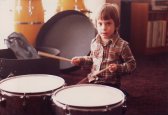
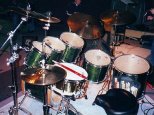 Growing up… I always liked the idea of playing the drums. I had my own Muppet Show drumset when I was very young and even tried to play to my dad’s In-A-Gadda-Da-Vida album, but I didn’t actually start learning to play drums until December, 1996 –a few months after I turned twenty. My friend Kenny Harris (who is a pretty darn good keyboard player, by the way) showed me how to do a basic 4/4 beat and got me started on playing basic fills. I bought a nice pair of Afro brand (now Pearl) bongos at the beginning of 1997 , then a set of three fiberglass congas. After about three months of drumset practice, I started playing on and off with the youth worship band at church. I bought my Pearl ELX drums in the fall, as well as my lovely brass free-floating snare drum. After a few additions the next year or so, the set became a seven-piece kit with all Sabian cymbals, and a double-bass pedal.
Growing up… I always liked the idea of playing the drums. I had my own Muppet Show drumset when I was very young and even tried to play to my dad’s In-A-Gadda-Da-Vida album, but I didn’t actually start learning to play drums until December, 1996 –a few months after I turned twenty. My friend Kenny Harris (who is a pretty darn good keyboard player, by the way) showed me how to do a basic 4/4 beat and got me started on playing basic fills. I bought a nice pair of Afro brand (now Pearl) bongos at the beginning of 1997 , then a set of three fiberglass congas. After about three months of drumset practice, I started playing on and off with the youth worship band at church. I bought my Pearl ELX drums in the fall, as well as my lovely brass free-floating snare drum. After a few additions the next year or so, the set became a seven-piece kit with all Sabian cymbals, and a double-bass pedal.
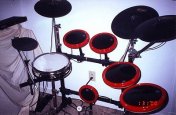 In 1999 I started tinkering with electronic drums, especially after finding the Logiztix website (now Electronicdrums.com) with simple instructions on how to convert a Remo practice pad into an electronic drum. I bought a remo practice pad kit and converted the whole thing, with the addition of a converted Remo Rototom for a snare, as well as converted practice cymbals. I found a used Alesis D4 drum module on Ebay for a great price to complete the package.
In 1999 I started tinkering with electronic drums, especially after finding the Logiztix website (now Electronicdrums.com) with simple instructions on how to convert a Remo practice pad into an electronic drum. I bought a remo practice pad kit and converted the whole thing, with the addition of a converted Remo Rototom for a snare, as well as converted practice cymbals. I found a used Alesis D4 drum module on Ebay for a great price to complete the package.
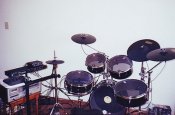 Not long afterward Pearl released the Rhythm Traveler practice kit with mesh heads. In 2000 spent the $400 on that and began converting it to electronic, as well, mainly using techniques found on the Electronicdrums.com site. I then spent about $900 on a Roland TD-8 module.
Not long afterward Pearl released the Rhythm Traveler practice kit with mesh heads. In 2000 spent the $400 on that and began converting it to electronic, as well, mainly using techniques found on the Electronicdrums.com site. I then spent about $900 on a Roland TD-8 module.
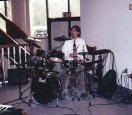 I enjoyed tinkering with the sounds for several months, but the Rhythm Traveler didn’t quite play as well as I had hoped. I later obtained a new ddrum-4 module, and after completely redesigning the “guts” of the kit, I was able to make it play almost exactly as I wanted, with positional sensing as well. (I basically recreated the insides of a typical ddrum pad using foam and an aluminum plate). I also discovered a rather simple way of testing the position-sensing accuracy of an e-drum pad for use with the ddrum-4 module .
I enjoyed tinkering with the sounds for several months, but the Rhythm Traveler didn’t quite play as well as I had hoped. I later obtained a new ddrum-4 module, and after completely redesigning the “guts” of the kit, I was able to make it play almost exactly as I wanted, with positional sensing as well. (I basically recreated the insides of a typical ddrum pad using foam and an aluminum plate). I also discovered a rather simple way of testing the position-sensing accuracy of an e-drum pad for use with the ddrum-4 module .
After a couple months of messing around on my “perfect” edrums with ddrum brain, I realized that the thing keeping my interest in the electronic drums was the very effort of trying to get them “just right.” It became a hobby to me (and a frustrating one at that) rather than a tool for practicing. Hobbies are great, but I figured that losing about two years worth of practice in favor of tinkering and maintenance was not the best trade-off (not to mention the financial cost). So I sold my Rhythm Traveler and ddrum module the summer of 2001 . Every once in a while, I would send an email to the guy who bought them and he tells me he couldn’t be happier. At least someone’s getting some good use out of them. I started playing in another band in a different church late in 2001, and continued on with that worship team until 2004. Unfortunately, I have not actively played with any bands since then.
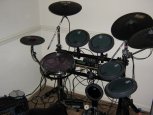 We had two incidents involving cat urine and the acoustic drums while they were set up in my parents’ basement, so we had them packed away for a while (yeah, that was pretty awful, but no permanent damage done). In February 2007 I took out what leftover electronic drum components I still had (including my nice Rototom snare) and bought some Peace brand practice pads on Ebay, as well as a used (well-used) Alesis DM-5. That’s the same 1995 drum module technology that I played with on the set at our old church–open/close only “switch” hi hat pedal and all. Based on the old Electronicdrums.com information, and some innovation of my own, I came up with a trigger scheme for the pads that seems to work quite well with the old DM-5 (after only a week or two of tinkering!). So with my existing gear plus $500 more spent, I now I have a usable set-up at home, and I can still play my acoustics in my parents’ basement. Sweet!
We had two incidents involving cat urine and the acoustic drums while they were set up in my parents’ basement, so we had them packed away for a while (yeah, that was pretty awful, but no permanent damage done). In February 2007 I took out what leftover electronic drum components I still had (including my nice Rototom snare) and bought some Peace brand practice pads on Ebay, as well as a used (well-used) Alesis DM-5. That’s the same 1995 drum module technology that I played with on the set at our old church–open/close only “switch” hi hat pedal and all. Based on the old Electronicdrums.com information, and some innovation of my own, I came up with a trigger scheme for the pads that seems to work quite well with the old DM-5 (after only a week or two of tinkering!). So with my existing gear plus $500 more spent, I now I have a usable set-up at home, and I can still play my acoustics in my parents’ basement. Sweet!
Some fun & useful links:
Electronicdrums.com — Highly recommended if you are interested in do-it-yourself (DIY) electronic drums.
Acousticdrums.com — Acoustic site by the same people as Electronicdrums.com
Checking Position Sensing Accuracy of edrums with a Ddrum4 brain — I figured this out when messing with my own drums.
